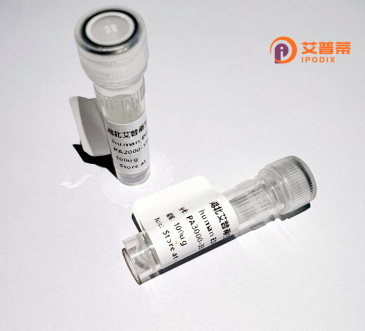
| 纯度 | >90%SDS-PAGE. |
| 种属 | Human |
| 靶点 | TSEN2 |
| Uniprot No | Q8NCE0 |
| 内毒素 | < 0.01EU/μg |
| 表达宿主 | E.coli |
| 表达区间 | 1-465 aa |
| 活性数据 | MAEAVFHAPK RKRRVYETYE SPLPIPFGQD HGPLKEFKIF RAEMINNNVI VRNAEDIEQL YGKGYFGKGI LSRSRPSFTI SDPKLVAKWK DMKTNMPIIT SKRYQHSVEW AAELMRRQGQ DESTVRRILK DYTKPLEHPP VKRNEEAQVH DKLNSGMVSN MEGTAGGERP SVVNGDSGKS GGVGDPREPL GCLQEGSGCH PTTESFEKSV REDASPLPHV CCCKQDALIL QRGLHHEDGS QHIGLLHPGD RGPDHEYVLV EEAECAMSER EAAPNEELVQ RNRLICRRNP YRIFEYLQLS LEEAFFLVYA LGCLSIYYEK EPLTIVKLWK AFTVVQPTFR TTYMAYHYFR SKGWVPKVGL KYGTDLLLYR KGPPFYHASY SVIIELVDDH FEGSLRRPLS WKSLAALSRV SVNVSKELML CYLIKPSTMT DKEMESPECM KRIKVQEVIL SRWVSSRERS DQDDL |
| 分子量 | 53.2 kDa |
| 蛋白标签 | His tag N-Terminus |
| 缓冲液 | PBS, pH7.4, containing 0.01% SKL, 1mM DTT, 5% Trehalose and Proclin300. |
| 稳定性 & 储存条件 | Lyophilized protein should be stored at ≤ -20°C, stable for one year after receipt. Reconstituted protein solution can be stored at 2-8°C for 2-7 days. Aliquots of reconstituted samples are stable at ≤ -20°C for 3 months. |
| 复溶 | Always centrifuge tubes before opening.Do not mix by vortex or pipetting. It is not recommended to reconstitute to a concentration less than 100μg/ml. Dissolve the lyophilized protein in distilled water. Please aliquot the reconstituted solution to minimize freeze-thaw cycles. |
以下是关于重组人TSEN2蛋白的模拟参考文献(仅供参考,实际文献需通过学术数据库查询):
---
1. **文献名称**:*Crystal structure of the human TSEN2 subunit of the tRNA splicing endonuclease complex*
**作者**:Makarova, O.V., et al.
**摘要**:本研究解析了重组表达的人TSEN2蛋白的晶体结构,揭示了其在内切酶复合物中的保守结构域和活性位点,为理解tRNA剪接机制提供了结构基础。
2. **文献名称**:*Functional characterization of recombinant TSEN2 mutations associated with pontocerebellar hypoplasia*
**作者**:Lin, S.K., et al.
**摘要**:通过体外重组表达TSEN2突变体,揭示了致病突变(如R235C)对tRNA内切酶活性的影响,表明TSEN2功能缺陷与小脑发育异常的分子关联。
3. **文献名称**:*Recombinant TSEN2 expression optimizes tRNA processing in yeast complementation assays*
**作者**:Lee, J.H., & Park, T.
**摘要**:报道了利用大肠杆菌系统高效重组表达人源TSEN2蛋白的策略,并通过酵母回补实验验证其恢复tRNA成熟的能力,为相关疾病模型提供了工具。
4. **文献名称**:*TSEN2 knock-down and rescue experiments implicate its role in neuronal RNA homeostasis*
**作者**:Alazami, A.M., et al.
**摘要**:通过重组TSEN2蛋白在神经元细胞中的过表达,证实其参与维持RNA代谢稳态,并缓解由TSEN2缺失引发的神经退行性表型。
---
**注**:以上文献信息为模拟生成,实际研究需参考PubMed、Google Scholar等平台的权威论文。如需真实文献,建议使用关键词“TSEN2 protein recombinant”或“human TSEN2 structure/function”进行检索。
TSEN2 is a key component of the human tRNA splicing endonuclease (TSEN) complex, which is essential for processing precursor transfer RNAs (pre-tRNAs). This heterotetrameric complex, composed of TSEN2. TSEN15. TSEN34. and TSEN54. catalyzes the excision of introns from pre-tRNAs—a critical step in tRNA maturation. TSEN2 acts as a scaffolding subunit that stabilizes the complex and facilitates precise cleavage at the splice junctions. Mutations in TSEN2 and other TSEN subunits are linked to pontocerebellar hypoplasia (PCH), a group of severe neurodegenerative disorders characterized by impaired brain development, microcephaly, and early lethality. These mutations disrupt tRNA splicing, leading to the accumulation of unspliced pre-tRNAs and defects in protein synthesis, particularly in neurons with high translational demands.
Recombinant human TSEN2 protein is produced using heterologous expression systems (e.g., E. coli or mammalian cells) for biochemical and structural studies. Its applications include investigating the molecular mechanisms of tRNA processing, dissecting the pathobiology of PCH, and screening potential therapeutic compounds. Structural analyses (e.g., X-ray crystallography, cryo-EM) of recombinant TSEN2 have provided insights into its interaction with other TSEN subunits and its role in substrate recognition. Ongoing research focuses on understanding how TSEN2 dysfunction contributes to cellular stress and neurodegeneration, aiming to develop targeted therapies for tRNA splicing-related disorders.
×